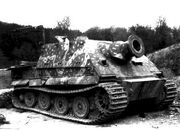The Sturmtiger (official German designation: Sturmmörserwagen 606/4 mit 38 cm RW 61) is the StuG's successor, enjoying slightly more firepower and range than its counterpart. The Sturmtiger can also resist more tank shots than the StuG.
Sturmtigers should be kept in their own 'group' as they will slow down any tank battalions it is placed in. A few of these, lagging behind a major tank front will help in the pounding of enemy armor.
They can also be used as a powerful defensive unit against advanced enemy units. Their armour is also very impressive, to be in comparison with other factions' mechanised artillery units. It is very expensive, very slow and also, it takes a while to produce one of these. As even the American Priest have more range than the Sturmtiger, their range is very reduced, but their still enjoy more than the Stug.
Sturmtigers are very resistant, capable of taking 7 shots of bazooka fire and still being able to attack. Its damage is very high, capable of destroying an infantry unit with only two shots. However, when a unit comes too close for them, they can still retreat and wait for reinforcements, as their resistance lets them retreat without being destroyed.
History[]

The idea for a heavy infantry support vehicle capable of demolishing heavily defended buildings or fortified areas with a single shot came out of the experiences of the heavy urban fighting in the Battle of Stalingrad in 1942. At the time, the Wehrmacht had only the Sturm-Infanteriegeschütz 33B available for destroying buildings, a Sturmgeschütz III variant armed with a 15 cm sIG 33 heavy infantry gun. Twelve of them were lost in the fighting at Stalingrad.
Its successor, the Sturmpanzer IV/Brummbär was in production from early 1943, but the Wehrmacht still saw a need for a similar, but heavier armoured and armed vehicle. Therefore a decision was made to create a new vehicle based on the Tiger tank and arm it with a 210 mm howitzer.
However, this weapon turned out not to be available at the time and was therefore replaced by a 380 mm rocket launcher, which was adapted from a Kriegsmarine depth charge launcher.
In September 1943 plans were made for Krupp to fabricate new Tiger I armored hulls for the Sturmtiger. The Tiger I hulls were to be sent to Henschel for chassis assembly and then to Alkett where the superstructures would be mounted. The first prototype was ready and presented to Adolf Hitler in October 1943. Delivery of the first hulls would occur in December 1943, with the first three Sturmtigers completed by Alkett by 20 February 1944.
Due to delays, Hitler did not request production of the weapon until 19 April 1944; 12 superstructures and weapons for the Sturmtiger would be prepared and mounted on rebuilt Tiger I chassis. The first three production series Sturmtigers were completed by Alkett in August 1944. Plans to complete an additional seven 38 cm Sturmtigers from 15 to 21 September 1944 were presented to Hitler in a conference on 18–20 August 1944. Ten Sturmtigers were produced in September, along with an additional five in December 1944.
Hitler had laid great importance on the special employment of the Sturmtiger and believed it would be necessary to produce at least 300 rounds of ammunition per month.
The Sturmtiger was intended to serve as a heavy infantry support vehicle, rendering assistance with attacks on heavily fortified or built-up areas. By the time the first Sturmtigers were available, however, the situation for Germany had changed for the worse, with the Wehrmacht being almost exclusively on the defensive rather than the offensive.
Three new Panzer companies were raised to operate the Sturmtiger: Panzer Sturmmörser Kompanien (PzStuMrKp) (Armored Assault Mortar Company) 1000, 1001 and 1002. These originally were supposed to be equipped with fourteen vehicles, but this figure was later reduced to four each, divided into two platoons.
PzStuMrKp 1000 was raised on 13 August 1944 and fought during the Warsaw Uprising with two vehicles, as did the prototype in a separate action, which may have been the only time the Sturmtiger was used in its intended role. PzStuMrKp 1001 (commanded by Captain von Gottberg) and 1002 (commanded by Lieutenant Zippel) followed in September and October. Both PzStuMrKp 1000 and 1001 served during the Ardennes Offensive, with a total of seven Sturmtigers.
After this offensive, the Sturmtigers were used in the defense of Germany proper, mainly on the Western front.
Overview[]
- These are best deployed in small, well protected groups of three or four. In these numbers, they are deadly against any structures and tight-knit groups of infantry, towed artillery, and anti-tank guns.
- These are borderline useless against any armor heavier than a Panzer III, so be sure to support them with tank destroyers and recon units.
- Sturmtigers are best deployed in the mid-late game, where you have advanced far enough on the enemy where these can pound their main production bases and HQ. This can save time and lives, as by this point, the enemy has probably stubbornly dug into the forests and fields surrounding their base.
- Sturmtiger are great for counter-battery operations, as it's thick armor made it highly resistant against enemy artillery, and their 380mm gun inflicts very high damage so powerful that it can destroy towed artillery in one shot.
Pros & Cons[]
This section is a stub, so be patient and expand it.
Weapons[]
| Weapon | ||||||||||
|---|---|---|---|---|---|---|---|---|---|---|
Hvy Assault Gun |
43 | 43 | 43 | 9 | 4 | 2 | 1 | 0 | 700 m |
Gallery[]
See also[]
| ||||||||||||||||||||||||||

